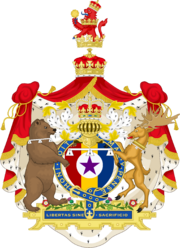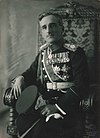Duke of Colorado: Difference between revisions
Centrist16 (talk | contribs) |
Centrist16 (talk | contribs) |
||
| Line 36: | Line 36: | ||
The title was created on December 11, 1876 by [[Charles I of Sierra|Charles I]]. He conferred the title to his eldest son, [[Louis I of Sierra|Prince Lewis]] at the prince's investiture ceremony. The title occurred during the final months of the [[Sierran Civil War]], a conflict which was fought over the issue of [[Monarchism in Sierra|monarchism]] and [[Republicanism in Sierra|republicanism]]. The creation of titles and development of the Sierran peerage system was controversy during the infancy of the Kingdom. Charles I exercised cautious restraint when he created new titles, especially hereditary ones, which he granted to political and financial allies of the Crown. During the Sierran Civil War, the Republicans were able to gain control over much of the [[Styxie]] and Northern Sierra as the self-declared [[Second California Republic]]. Republican advances nearly jeopardized the Kingdom's future when republican forces approached the national capital of [[Porciúncula]] in the spring of 1875. After the pivotal [[Folly at Tejon Pass]], the Monarchist forces reversed Republican gains and over the next two years, the Kingdom was able to slowly reclaim all of Sierra. The king's move to publicly bestow his heir with a title was deliberate as it represented confidence by the King that the Kingdom would be preserved and the defeat of the Republicans was all but certain. The Duke of Colorado was one of the first titles created specifically for members of the Royal Family. The title signaled to opponents of the Crown that the monarchy had become entrenched as a national institution and would be continued on by the King's successors. | The title was created on December 11, 1876 by [[Charles I of Sierra|Charles I]]. He conferred the title to his eldest son, [[Louis I of Sierra|Prince Lewis]] at the prince's investiture ceremony. The title occurred during the final months of the [[Sierran Civil War]], a conflict which was fought over the issue of [[Monarchism in Sierra|monarchism]] and [[Republicanism in Sierra|republicanism]]. The creation of titles and development of the Sierran peerage system was controversy during the infancy of the Kingdom. Charles I exercised cautious restraint when he created new titles, especially hereditary ones, which he granted to political and financial allies of the Crown. During the Sierran Civil War, the Republicans were able to gain control over much of the [[Styxie]] and Northern Sierra as the self-declared [[Second California Republic]]. Republican advances nearly jeopardized the Kingdom's future when republican forces approached the national capital of [[Porciúncula]] in the spring of 1875. After the pivotal [[Folly at Tejon Pass]], the Monarchist forces reversed Republican gains and over the next two years, the Kingdom was able to slowly reclaim all of Sierra. The king's move to publicly bestow his heir with a title was deliberate as it represented confidence by the King that the Kingdom would be preserved and the defeat of the Republicans was all but certain. The Duke of Colorado was one of the first titles created specifically for members of the Royal Family. The title signaled to opponents of the Crown that the monarchy had become entrenched as a national institution and would be continued on by the King's successors. | ||
Throughout the title's existence, the Duke of Colorado has borne no formal responsibilities or duties. As a substantive title lacking inheritability, there is no estate or property attached to the title. However, starting with the reign of [[Louis I of Sierra|Louis I]] and the investiture of [[Louis II of Sierra|Louis II]] as Duke of Colorado, the title has always been conferred alongside the subsidiary titles of [[Earl of Aspen]] and [[Baron Bel Air]], which do provide sources of income from property held by the titles. Originally, the title was reserved only to the monarch's eldest living son, but this was changed during the reign of King [[Louis III of Sierra|Louis III]], when Parliament changed the rules of succession from {{W|agnatic primogeniture}} to {{W|absolute primogeniture}} for both the monarchy and the royal dukedoms. [[Elizabeth I of Sierra|Princess Alexis]] (who later became Queen Elizabeth I) became the first substantive female holder of the title. | Throughout the title's existence, the Duke of Colorado has borne no formal responsibilities or duties. As a substantive title lacking inheritability, there is no estate or property attached to the title, unlike the [[Duke of Newark]], [[Duke of Albany]], and [[Duke of York]] which have always been reserved only to the heir apparent and not the heir presumptive. However, starting with the reign of [[Louis I of Sierra|Louis I]] and the investiture of [[Louis II of Sierra|Louis II]] as Duke of Colorado, the title has always been conferred alongside the subsidiary titles of [[Earl of Aspen]] and [[Baron Bel Air]], which do provide sources of income from property held by the titles. The [[Chief of Hawaii Island]] was a title that was added in 1950 after [[Hawaii]] became a [[Countries of the Kingdom of Sierra|constituent country]] with a [[Monarchy of Sierra|subnational principality]]. Originally, the title was reserved only to the monarch's eldest living son, but this was changed during the reign of King [[Louis III of Sierra|Louis III]], when Parliament changed the rules of succession from {{W|agnatic primogeniture}} to {{W|absolute primogeniture}} for both the monarchy and the royal dukedoms. [[Elizabeth I of Sierra|Princess Alexis]] (who later became Queen Elizabeth I) became the first substantive female holder of the title. | ||
==Investiture== | ==Investiture== | ||
Revision as of 04:46, 9 August 2021
| Dukedom of Colorado | |
|---|---|
 | |
| Creation date | December 11, 1876 |
| Creation | First |
| Monarch | Queen Elizabeth II |
| Peerage | Peerage of Sierra |
| Present holder | Princess Clara Maria, Duchess of Colorado |
| Heir presumptive | Prince Marc, Duke of Sonora |
| Remainder to | the 1st Duke's heirs general of the body lawfully begotten |
| Subsidiary titles |
Earl of Aspen Baron Bel Air Chief of Hawaii Island |
| Status | Extant |
Duke of Colorado (or Duchess of Colorado if the holder is female), named after the Colorado River, is a substantive title in the Peerage of Sierra, traditionally and ceremonially conferred by the Sierran monarch to their heir apparent or heir presumptive. It is not inheritable and is merged with the Crown upon acceding the throne. The Duke of Colorado is commonly associated with a number of subsidiary titles, including the Earl of Aspen, Baron Bel Air, and Chief of Hawaii Island. The title's conferral is not required and failure to be granted the title does not affect the rights of royal succession.
The current Duchess of Colorado is Princess Clara Maria, the sister of Queen Elizabeth II and second eldest child of King Emeritus Charles II. The spouse of the Duke or Duchess of Colorado is entitled the gender-equivalent courtesy title.
Roles and responsibilities
The Duke of Colorado is the heir apparent or presumptive of the Sierran monarch. No formal legal or public role of the title has ever been established by Parliament. In practice, the Duke of Colorado serves as the monarch's primary representative within the royal family and assists the monarch with their royal duties. Titleholders who have attained the age of majority may be appointed as a Counselor of State and may serve as a sitting member within the Privy Council of Sierra. In addition, the Duke of Colorado is one of three titles that may issue royal warrant of appointment.
History

The title was created on December 11, 1876 by Charles I. He conferred the title to his eldest son, Prince Lewis at the prince's investiture ceremony. The title occurred during the final months of the Sierran Civil War, a conflict which was fought over the issue of monarchism and republicanism. The creation of titles and development of the Sierran peerage system was controversy during the infancy of the Kingdom. Charles I exercised cautious restraint when he created new titles, especially hereditary ones, which he granted to political and financial allies of the Crown. During the Sierran Civil War, the Republicans were able to gain control over much of the Styxie and Northern Sierra as the self-declared Second California Republic. Republican advances nearly jeopardized the Kingdom's future when republican forces approached the national capital of Porciúncula in the spring of 1875. After the pivotal Folly at Tejon Pass, the Monarchist forces reversed Republican gains and over the next two years, the Kingdom was able to slowly reclaim all of Sierra. The king's move to publicly bestow his heir with a title was deliberate as it represented confidence by the King that the Kingdom would be preserved and the defeat of the Republicans was all but certain. The Duke of Colorado was one of the first titles created specifically for members of the Royal Family. The title signaled to opponents of the Crown that the monarchy had become entrenched as a national institution and would be continued on by the King's successors.
Throughout the title's existence, the Duke of Colorado has borne no formal responsibilities or duties. As a substantive title lacking inheritability, there is no estate or property attached to the title, unlike the Duke of Newark, Duke of Albany, and Duke of York which have always been reserved only to the heir apparent and not the heir presumptive. However, starting with the reign of Louis I and the investiture of Louis II as Duke of Colorado, the title has always been conferred alongside the subsidiary titles of Earl of Aspen and Baron Bel Air, which do provide sources of income from property held by the titles. The Chief of Hawaii Island was a title that was added in 1950 after Hawaii became a constituent country with a subnational principality. Originally, the title was reserved only to the monarch's eldest living son, but this was changed during the reign of King Louis III, when Parliament changed the rules of succession from agnatic primogeniture to absolute primogeniture for both the monarchy and the royal dukedoms. Princess Alexis (who later became Queen Elizabeth I) became the first substantive female holder of the title.
Investiture
Investiture is optional as it is not necessary to be created Duke of Colorado. To date however, all Dukes of Colorado have had an investiture ceremony. As with most investitures in Sierra, the investiture of Duke of Colorado has been usually held within the Senate chambers of Parliament Building. During the ceremony, as the letters patent are read to create the dignity, the Duke of Colorado is presented to wear the Regalia of Colorado, made up of a coronet bearing four crosses pattée alternating with four Colorado blue columbines, a ring, a mantle, a girdle, a rod, and a sword. Notably, during the investiture of Princess Alexis, she was given a musket rather than a sword.
Other titles
The titles Earl of Aspen, Baron Bel Air, and Chief of Hawaii Island have been granted automatically to holders of the Duke of Colorado. If the titleholder is an heir apparent, they may be conferred the titles Duke of Albany, Duke of Newark, and Duke of York. Individual princes and princesses may also hold additional titles, which they held prior to their investiture as Duke of Colorado.






